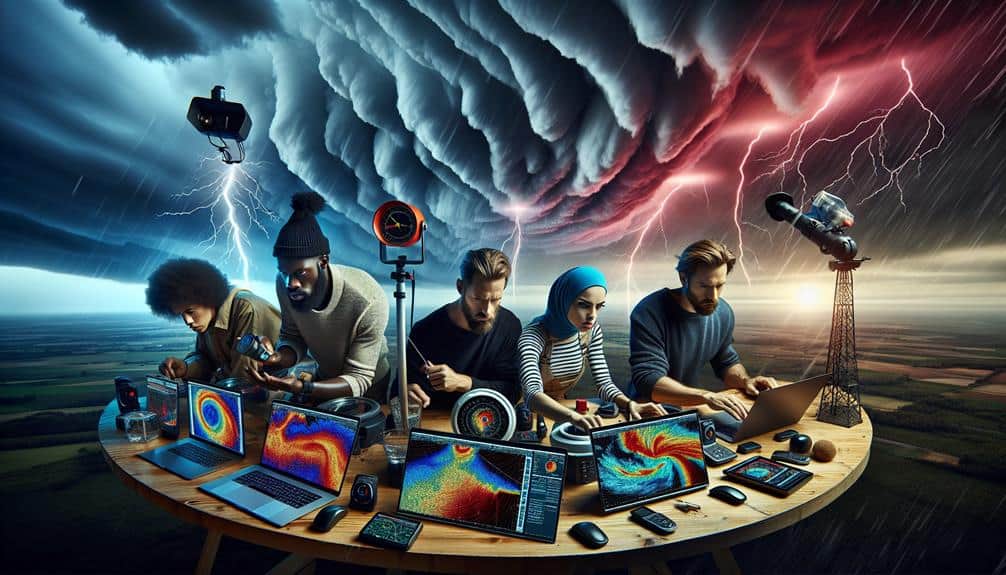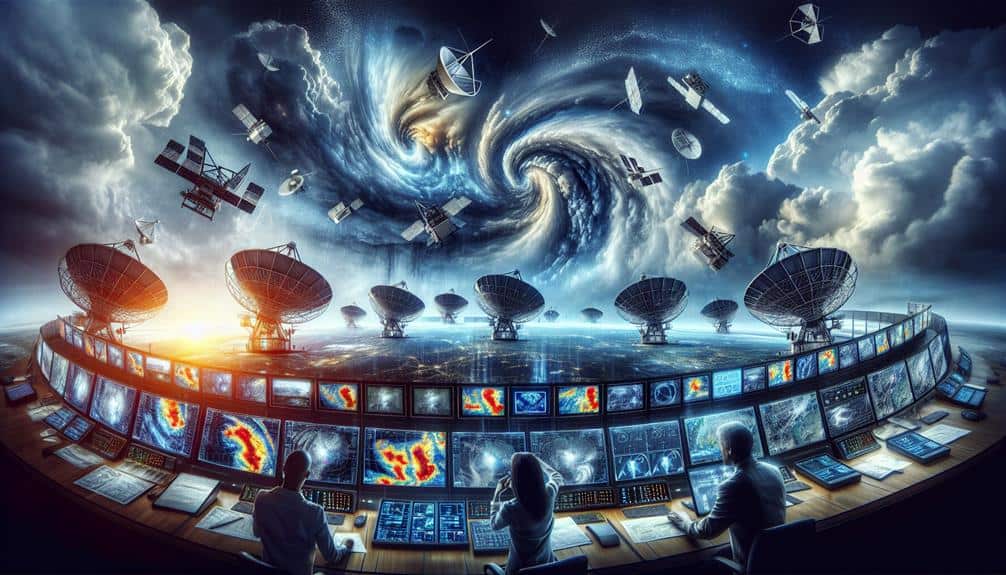Tracking storm directions is essential for multiple reasons. First, it guarantees our personal safety and enables us to implement timely safety precautions. Second, it optimizes storm chasing strategies, improving data collection efficiency and accuracy. Third, understanding storm trajectories enhances the quality of data we gather, strengthening meteorological research. Fourth, accurate tracking assists in making dependable weather forecasts, which is crucial for decision-making and economic stability. To conclude, it raises public awareness, equipping communities with the knowledge to better anticipate and respond to severe weather impacts. There's much more to uncover about the importance of storm tracking and its benefits.
Key Points
- Enhances emergency preparedness by providing advanced warnings.
- Reduces risks through timely implementation of safety precautions.
- Improves forecast accuracy, aiding reliable weather predictions.
- Optimizes data collection for better meteorological research and analysis.
Ensure Personal Safety
Tracking storm directions is crucial because it allows us to make informed decisions to protect our lives and well-being. By closely monitoring weather patterns, we can greatly improve our emergency preparedness and risk reduction efforts. Accurate weather monitoring enables us to anticipate severe weather events, providing us with ample time to implement safety precautions. This proactive approach not only minimizes potential harm but also helps us maintain our freedom to live our lives without unnecessary disruptions.
When we monitor storm movements, we can identify high-risk areas and plan accordingly. This detailed awareness facilitates timely evacuations and ensures that emergency services are adequately prepared to respond. Additionally, understanding storm trajectories helps us secure our homes, stockpile essential supplies, and avoid hazardous areas, thereby reducing the likelihood of injury or property damage.
In essence, weather monitoring acts as an early warning system, empowering us to take decisive actions. It's not just about reacting to storms but proactively preparing for them. By prioritizing safety precautions and being vigilant about storm directions, we can protect ourselves and our communities, allowing us to live more freely and securely in the face of nature's unpredictability.
Optimize Storm Chasing Strategies
By examining storm directions closely, we can refine our storm chasing strategies, maximizing both safety and data collection efficiency. Knowing precisely where a storm is heading allows us to plan our routes effectively, guaranteeing we stay within best proximity for observation while avoiding risky conditions.
This strategic planning begins with thorough equipment preparation; we must equip our vehicles with the latest tracking technology, high-resolution cameras, and meteorological instruments. Each piece of equipment needs to be checked and calibrated to function flawlessly under extreme conditions.
Our observation techniques also benefit greatly from understanding storm trajectories. By positioning ourselves based on the storm's projected path, we can select the best vantage points for capturing critical data without being obstructed by barriers like trees or buildings. This enables us to utilize advanced tools like drones and portable weather stations to their fullest potential, gathering valuable insights from multiple angles.
Furthermore, by tracking storms in real-time, we can dynamically adjust our strategies, guaranteeing we capture the most relevant phenomena while maintaining a safe distance. This blend of careful planning and adaptive techniques empowers us to chase storms effectively, satisfying both our scientific curiosity and our desire for freedom in exploration.
Enhance Data Collection
Understanding storm trajectories not only optimizes our chasing strategies but also greatly enhances our data collection capabilities. By accurately tracking the direction of storms, we can position ourselves in the most strategic locations to gather high-quality data. This data is vital for in-depth research analysis, allowing us to understand storm behavior, intensity, and patterns more thoroughly.
Moreover, the integration of technology advancements in our tracking systems enables us to collect data more efficiently and accurately. High-resolution satellite imagery, Doppler radar systems, and advanced computer models all play an essential role in refining our data collection methods. These tools provide us with real-time information, ensuring that our data is both current and precise.
When we combine our improved positioning with these technological tools, we can capture a more detailed picture of storm dynamics. This enhanced data collection doesn't just benefit our immediate research goals; it also contributes to a larger body of knowledge that can be used by meteorologists and climate scientists worldwide. By continually advancing our data collection methods, we empower ourselves to make more informed decisions and push the boundaries of meteorological science.
Improve Forecast Accuracy
Accurately predicting storm paths greatly enhances our ability to provide timely and reliable weather forecasts. By monitoring storm directions, we can refine our models and improve the precision of our predictions. This advancement directly translates to several key benefits:
- Research benefits: Tracking storm paths aids in the collection of valuable data, which researchers can use to analyze weather patterns and refine predictive algorithms. This leads to a deeper understanding of atmospheric dynamics.
- Technology advancements: Utilizing cutting-edge technology, such as satellite imagery and Doppler radar, allows us to gather more accurate and thorough data. These technological tools enable us to predict storm movements with higher accuracy.
- Enhanced decision-making: Improved forecast accuracy empowers us to make better-informed decisions regarding emergency responses, resource allocation, and public safety measures. This is vital in minimizing the impact of severe weather events.
Contribute to Public Awareness

Educating the public on storm directions plays a pivotal role in enhancing community preparedness and resilience against severe weather events. By understanding the trajectory of storms, we can better inform our communities about potential threats, allowing for timely disaster response and mitigation measures.
Educational outreach programs are essential in disseminating this information, helping individuals make informed decisions to protect their families and properties.
We must recognize the significant environmental impact that storms can have. By tracking storm directions and sharing this data, we empower communities to anticipate and reduce these impacts. This proactive approach not only safeguards lives but also preserves our natural habitats. In doing so, we strengthen the collective resilience of our society.
In our pursuit of freedom, knowledge about storm directions grants us the ability to make autonomous decisions in the face of adversity. It equips us with the tools to prepare and respond effectively. Our commitment to community preparedness through educational outreach guarantees that everyone, regardless of background, has access to life-saving information.
Ultimately, a well-informed public is a resilient public, ready to face the challenges posed by severe weather events head-on.
Frequently Asked Questions
How Is Storm Direction Tracking Technology Evolving?
We're seeing rapid advancements in storm direction tracking technology. Emerging technologies, like AI and machine learning, enhance predictive accuracy, while improved data visualization tools offer clearer, more detailed insights, empowering us to make informed decisions quickly.
What Equipment Is Needed for Accurate Storm Direction Tracking?
Unlike outdated methods, modern equipment guarantees accuracy in storm direction tracking. We need Doppler radar, satellite imagery, and advanced computer models. These tracking technology improvements allow us to predict storms precisely, granting us the freedom to prepare.
Can Storm Tracking Help in Predicting Agricultural Impacts?
Yes, storm tracking can greatly enhance agricultural forecasting. By analyzing storm patterns, we bolster climate resilience, enabling farmers to make informed decisions, protect crops, and guarantee sustainable yields despite unpredictable weather conditions.
How Do Different Regions Benefit From Storm Direction Data?
Different regions benefit from storm direction data through enhanced disaster preparedness and reduced economic impacts. We use this data for environmental monitoring and climate change adaptation, ensuring communities can adapt and thrive while safeguarding their freedoms.
What Are the Historical Advancements in Storm Tracking Methods?
We've seen incredible advancements in storm tracking methods! Satellite imagery and radar have revolutionized our ability to forecast storms. Historical data enhances our predictions, offering the freedom to prepare and respond like never before.

